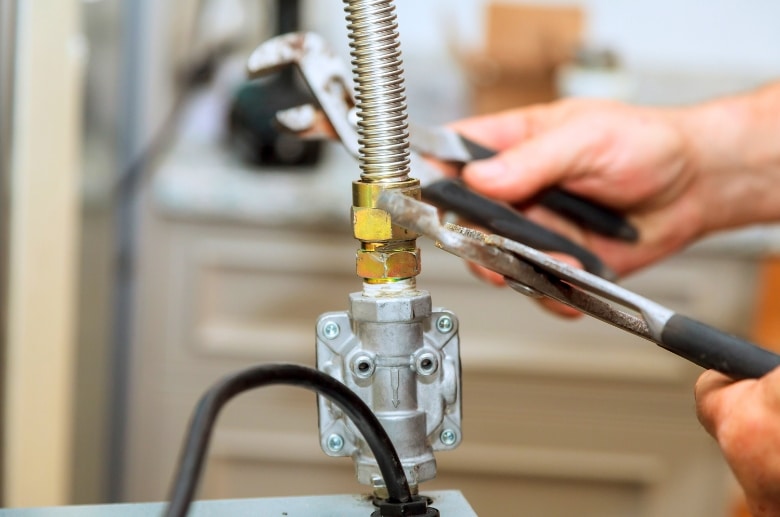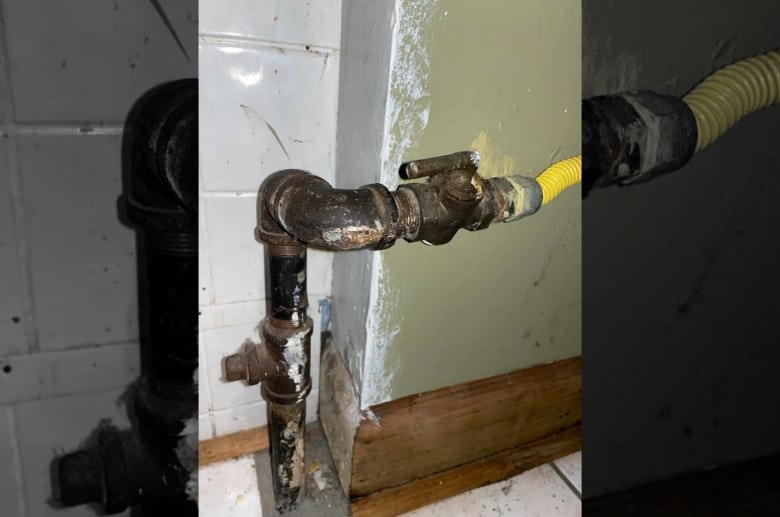Gas fireplaces are popular among homeowners because they offer convenience, warmth, and ambiance at cheaper rates. However, it’s important to be aware of their typical lifespan of different fireplaces, including gas ones, as this knowledge is crucial in understanding when to expect and address potential issues like gas leaks.
Gas leaks can be hazardous, threatening both the occupants and the property. But by prioritizing maintenance and staying vigilant of potential signs of gas leaks, you can enjoy the warmth of your gas fireplace with peace of mind.
In this blog, we will discuss gas fireplace leak symptoms and why leaks occur in the first place. We will also talk about five essential alarm signals that homeowners should look for to take proactive safety measures and enjoy the warmth of their gas appliances without worry.
What Causes Gas Fireplace Leaks?
Gas fireplace leaks can be caused by various factors that compromise the integrity of the gas supply system. Understanding and fixing common fireplace issues, including these leaks, is essential for maintaining your fireplace’s safety and efficiency.
Here are four common causes of gas fireplace leaks:
Damaged Gas Lines

Gas lines can sustain damage over time due to wear and tear or accidental incidents such as construction work or physical impact. Cracked or punctured gas lines can lead to a natural gas leak, posing a serious safety hazard.
It is crucial to regularly inspect the gas lines for any signs of damage and address them promptly to prevent leaks.
——
Do You Need to Hire Chimney & Fireplace Expert?
Get free quotes from qualified experts near you. No commitment required!
——
Loose Connections Between Gas Fittings
To ensure a proper seal, gas fittings, such as connectors and valves, must be tightly secured. If the connections become loose or improperly tightened, gas can escape through the gaps, resulting in a leak.
Regularly checking and tightening gas fittings is essential to maintain a secure and leak-free connection.
Corroded Pipes

Over time, gas pipes can corrode due to exposure to moisture, chemicals, or environmental factors. Rust and deterioration weaken the structural integrity of the pipes, making them more susceptible to leaks.
Inspecting the pipes for signs of corrosion, such as discoloration or flaking, is important. Rely on professional gas companies to replace the corroded sections of the pipes to ensure the safety and reliability of the gas supply system.
Malfunctioning Valves
Valves are crucial in regulating gas flow within the fireplace. If a valve malfunctions or becomes stuck in an open position, it can result in an uncontrolled or continuous flow of gas.
Regularly checking the functionality of the valves and addressing any issues promptly is necessary to prevent gas leaks and maintain proper gas flow regulation. However, gas systems require specialized knowledge and expertise to diagnose and repair. Attempting DIY repairs can be dangerous and may further exacerbate the issue.
By entrusting the task to a qualified professional, you can ensure the proper identification and resolution of gas fireplace leaks, maintaining the safety and functionality of your fireplace.
Gas Fireplace Leak Symptoms
Gas fireplace danger signs include the smell of gas or unusual odors (like rotten eggs), hissing or whistling sounds near gas lines, dead or discolored plants, and soot buildup around the fireplace. All of these indicate the presence of a gas leak. Also, occupants can experience headaches, dizziness, nausea, and breathing difficulties due to gas fireplace leaks.
Since gas fireplace leaks pose serious risks, it’s important to understand the danger signs. Call a professional to inspect your fireplace for leaks if you notice any of these.
1. The Smell of Gas or Unusual Odors (Rotten Egg Smell)
Did you ever smell a strange odor coming from your fireplace? The smell of natural gas, often described as a rotten egg smell, is a significant indicator of a gas leak. Natural gas is odorless, but an additive called mercaptan is added to give it a distinct smell for easy detection. If you detect this odor near your gas fireplace, it signifies a gas leak.
2. Dead or Discolored Plants

When houseplants in the room with the gas fireplace begin to discolor or even die, you might have a gas leak. If the grass outside seems to be dying in the area over the natural gas line, that indicates a leak in the pipes that lead to your home. It’s very important to remember that even the slightest spark could ignite the gas fumes, so call for help right away.
3. Strange Sounds
Hissing or whistling sounds near the gas lines indicate a potential leak in a gas fireplace. These sounds occur when there is an abnormal gas flow or a disruption in the gas line, such as a loose or damaged connection. Hissing or whistling sounds signify that gas is escaping, which poses a significant danger to your safety. If this happens, get your family out of the house and to safety, then call the gas service for help.
——
Do You Need to Hire Chimney & Fireplace Expert?
Get free quotes from qualified experts near you. No commitment required!
——
4. Soot Buildup Around the Fireplace
The presence of soot buildup around the fireplace is a noticeable symptom of a potential gas fireplace leak. Soot is a black, powdery substance that forms when combustion is incomplete or inefficient. When there is a gas leak or improper combustion in the fireplace, it can produce excessive soot that accumulates around the area.
Soot buildup not only ruins the aesthetics of the fireplace but also poses several health and safety risks. Excessive soot can obstruct ventilation, leading to poor indoor air quality and potential health hazards, including CO poisoning. Since soot is a flammable substance, its buildup can also increase the chances of fire hazards.
In addition to soot, another concern to be aware of is fireplace mold. This can occur in and around fireplaces due to moisture issues, and it’s crucial to identify and address it promptly, as it can pose significant health risks.
Suppose you notice significant soot buildup or signs of mold around your gas fireplace. In that case, it is crucial to address these issues promptly by calling professionals to diagnose and fix them before any harm is done.
5. Headaches, Dizziness, Nausea, and Breathing Difficulties

Gas leaks are dangerous as they can lead to fire hazards, explosions, and carbon monoxide poisoning. Experiencing symptoms such as headaches, dizziness, nausea, and breathing difficulties indicate a gas fireplace leak and its potential dangers.
When there is a gas leak, harmful gases like carbon monoxide are released into the air. Inhaling high levels of carbon monoxide can lead to severe health issues and even be life-threatening. It is crucial to turn off the gas supply immediately, ventilate (and evacuate) the area, and contact a professional to locate and repair the source of the leak.
Health and Safety Risks of Gas Leaks
Apart from the health risk, gas leaks also pose a fire hazard. Gas leakage can result in disastrous house fires in a matter of minutes, burning your valuables and putting the lives of your loved ones at risk.
Therefore, it is crucial for homeowners to install carbon monoxide detectors throughout their homes. Some local governments and regulatory bodies have even implemented legislation requiring the installation of carbon monoxide detectors.
These detectors are designed to sound an alarm when they detect high levels of carbon monoxide in the air, providing an early warning to occupants and allowing them to evacuate or take appropriate action.
Moreover, legal requirements regarding carbon monoxide detectors can vary depending on your jurisdiction. For example, in the United States, no federal law mandates carbon monoxide detector installation in all residential properties.
However, many states have implemented laws and building codes that require carbon monoxide detectors in certain types of dwellings, such as single-family homes, rental properties, or homes with fuel-burning appliances.
Homeowners should also review home insurance policies to understand coverage for potential damages caused by gas leaks and ensure compliance with safety regulations. However, prevention is always the best approach.
Regular maintenance, professional inspections, and prompt resolution of gas fireplace issues are essential to prevent gas leaks and the associated health and safety risks.
What to Do If You Suspect a Gas Leak
If you suspect a gas leak, it is crucial to prioritize your safety and take immediate action. Follow these steps if a gas leak is suspected:
- Turn off the gas supply at the main valve or meter by locating the main valve and rotating it clockwise until fully closed. This action stops the gas from entering your home and reduces the risk of fire or explosion.
- Evacuate the house immediately and call the gas company or emergency services from a safe location outside the premises.
- Refrain from using electrical switches or appliances that could create a spark and ignite the gas.
- Avoid opening windows or doors, as this could cause a sudden ignition or explosion.
Your primary focus should be ensuring your safety and that of your loved ones. Since gas leaks can be highly dangerous, attempting to repair them without the necessary expertise can lead to further complications or even catastrophic accidents.
That is why it is important to leave the task of addressing the gas leak to trained professionals with the expertise and equipment to handle such situations safely.
——
Do You Need to Hire Chimney & Fireplace Expert?
Get free quotes from qualified experts near you. No commitment required!
——
Fireplace Gas Leak Repair Cost
The costs can vary from $200 to $1,000 when repairing a gas fireplace leak, depending on several factors. Firstly, the severity of the leak plays a significant role in determining the overall repair costs. A minor leak requiring simple repairs may be less expensive than a major leak requiring extensive repairs.
Secondly, the required replacement parts can contribute to the overall cost. Depending on the specific components that need to be replaced, such as valves ($150 to $400), connectors ($50 and $150), or seals ($20 to $50), the prices can vary. Repairs can range from $150 to $500, while replacement costs can be between $20 and $1,000. On average, gas line repairs or replacements cost around $800.
Lastly, labor costs for professional repair services should be considered. The rates charged by technicians or contractors can vary based on their expertise and the complexity of the repair work. Also, the labor cost varies from locality to locality. Labor costs for gas leak repairs range from $75 to $150 per hour.
Generally, home insurance policies may cover damage caused by sudden and accidental incidents, including gas leaks. However, coverage can vary between policies and insurance providers. That is why it is important to review your policy to understand the specific terms and conditions.
Homeowners should document the incident thoroughly, including any damages or expenses related to the gas leak repair. When determining whether to file an insurance claim, consider the severity of the damage and the potential costs involved.
Suppose the repair costs are high or there is extensive damage to your property. In that case, promptly contacting your insurance provider and following their instructions for filing a claim is recommended.
Gas Leak Prevention Tips

To prevent gas fireplace leaks and to ensure the safety of your home, the following are important prevention tips to follow:
- Schedule annual inspections and maintenance by a professional to identify and address any potential issues.
- Never ignore any signs or symptoms of gas leaks; take immediate action if you notice anything unusual.
- Avoid DIY gas fireplace repairs or installations, which can pose significant risks.
- Install carbon monoxide detectors in your home and regularly test them to provide early warning of any potential leaks.
These prevention tips can help maintain a safe and secure gas fireplace environment.
Conclusion
Recognizing gas fireplace leak symptoms is critical to ensure the safety of your home. We discussed alarm signals, health risks like carbon monoxide poisoning, and the importance of carbon monoxide detectors.
If you suspect a gas leak, immediately turn off the gas supply, evacuate your home, and reach out for professional help.
Regular maintenance and inspections, avoiding DIY repairs, and installing detectors are essential to prevent potential leaks.
By taking these precautions, you can maintain a safe environment for your loved ones, allowing you to enjoy the warmth and comfort of your gas fireplace with peace of mind.






